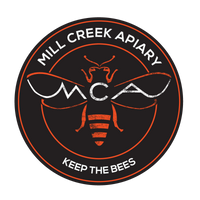At least once a day, we hear some form of the question, “Is it true I shouldn’t use a metal spoon in honey?” Since this claim continues to circle the internet, it’s time for a deep dive!
The Hypothesis
On first hearing this idea, it may seem logical in theory. Honey is acidic with a pH ranging from 3.4 to 6.1 and an average of 3.9. [1] Acids can corrode metals or cause chemical reactions. The fear is that such reaction may leach metals into honey or denature the beneficial enzymes. This makes wood or glass a safer non-reactive option.
A Closer Look
The first issue with this claim is its vagueness. “Metal” encompasses many different materials and not all are created equally. Plenty of metals are reactive, including iron, copper, aluminum, and tin. [2,3] However, stainless steel, which most food equipment is made of, is not reactive. Silver and gold are nonreactive as well. [2,3] It is also important to note that chemical reactions between honey and reactive metals would not be instantaneous. For example, if you were to leave a copper spoon in your jar, salts would form over time and denature honey’s valuable enzymes, but for the 30 seconds it takes to scoop some honey and stir it into tea, you’re likely in the clear.
Anecdotal Evidence
In my research, I could not find any official sources that have directly experimented with this claim. (If any of you have seen ‘google scholar worthy’ studies on honey and metal let us know!) The vast majority of sources touting the reactivity of honey and metals are tiktoks and blog posts. Without sufficient scientific data, the best people to trust are your local beekeepers. The majority of commercial honey processing equipment is stainless steel. Stainless steel is deemed by the industry to be a safe and most practical means for processing honey. Here at Mill Creek Apiary we are bottling out of stainless steel tanks. We haven’t noticed a decrease in the quality of our honey in its journey from hive to jar, nor have we heard concerns from fellow beekeepers.
Further Research
Failing to find satisfying research on honey and stainless steel specifically, I looked into stainless steel reactivity and corrosion in general. I could only find instances of stainless steel degradation in extreme acids, like hydrochloric or sulphuric, [4,5] or some extreme bases, particularly chloride solutions. [4,6] Based on this, it seems highly unlikely that a mild acid such as honey would have any negative effect. In fact, another study showed honey to have a protective quality to stainless steel when added to sulphuric acid. The polyphenols and flavonoids that give honey its beneficial antibacterial, anti-inflammatory, and antioxidant qualities create a film over the steel to provide anticorrosive and antioxidant properties therefore protecting the metal. This study displayed that as the concentration of honey added to the acid was increased, the metal lost less mass and had less visible corrosion. [7] I do not have professional training in chemistry, so I cannot be certain that this study is directly transferable to our question at hand, but it seems even more unlikely that honey alone would react with stainless steel, when it helps protect against the strongest acids!
In Conclusion
The origins of the metal spoon and honey myth remain a mystery, and until we have any direct and professional testing, it’s safe to say it is truly a myth. There is no evidence of reactivity or corrosion between honey and stainless steel, and certainly not in the short time it takes to scoop and use. For those looking to keep their honey at its most pure and beneficial, it’s more important to avoid plastic bottles and potential microplastic leeching [8] and to consume your honey at a temperature of 105°F or less to keep it raw.
Sources
- Detection Of The Electrical Conductivity And Acidity Of Honey From Different Areas Of Tepi
- Does A Metal Spoon Kill Enzymes In Honey?
- Processing Honey: A Closer Look
- What Forms Of Corrosion Can Occur In Stainless Steels.
- A Comprehensive Review Of Corrosion Inhibitors Employed To Mitigate Stainless Steel Corrosion In Different Environments
- Understanding Stainless Steel’s Corrosion-Resistant Properties - Unified Alloys
- Corrosion Inhibitive Behaviour Of The Natural Honey In Acidic Medium Of A315 Mild And 304 Austenitic Stainless Steels
- Honey Quality And Microplastic Migration From Food Packaging: A Potential Threat For Consumer Health?

Thank You.
Leave a comment